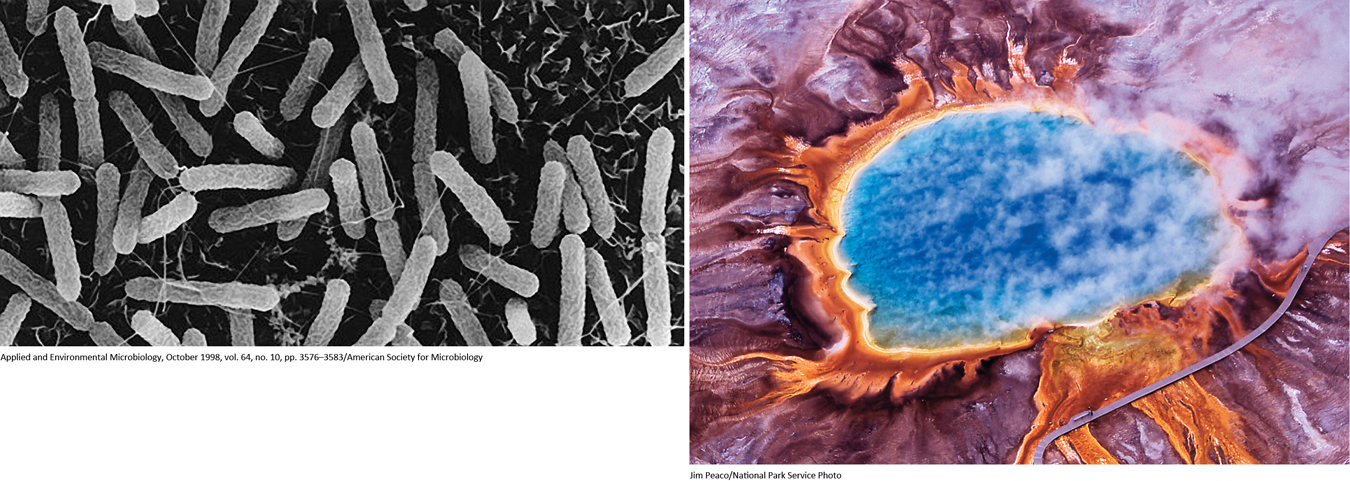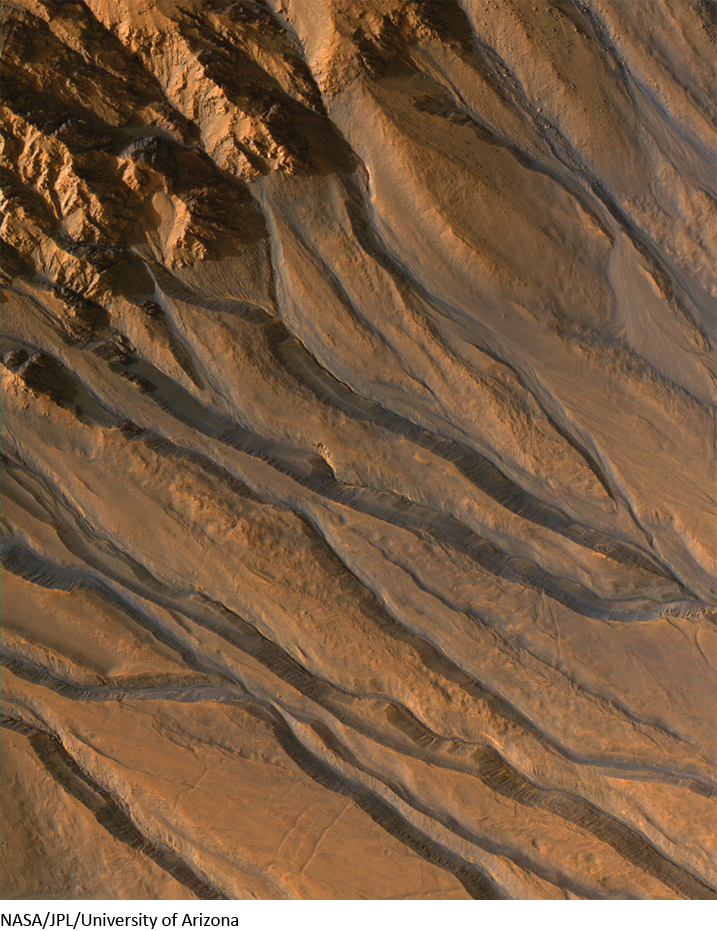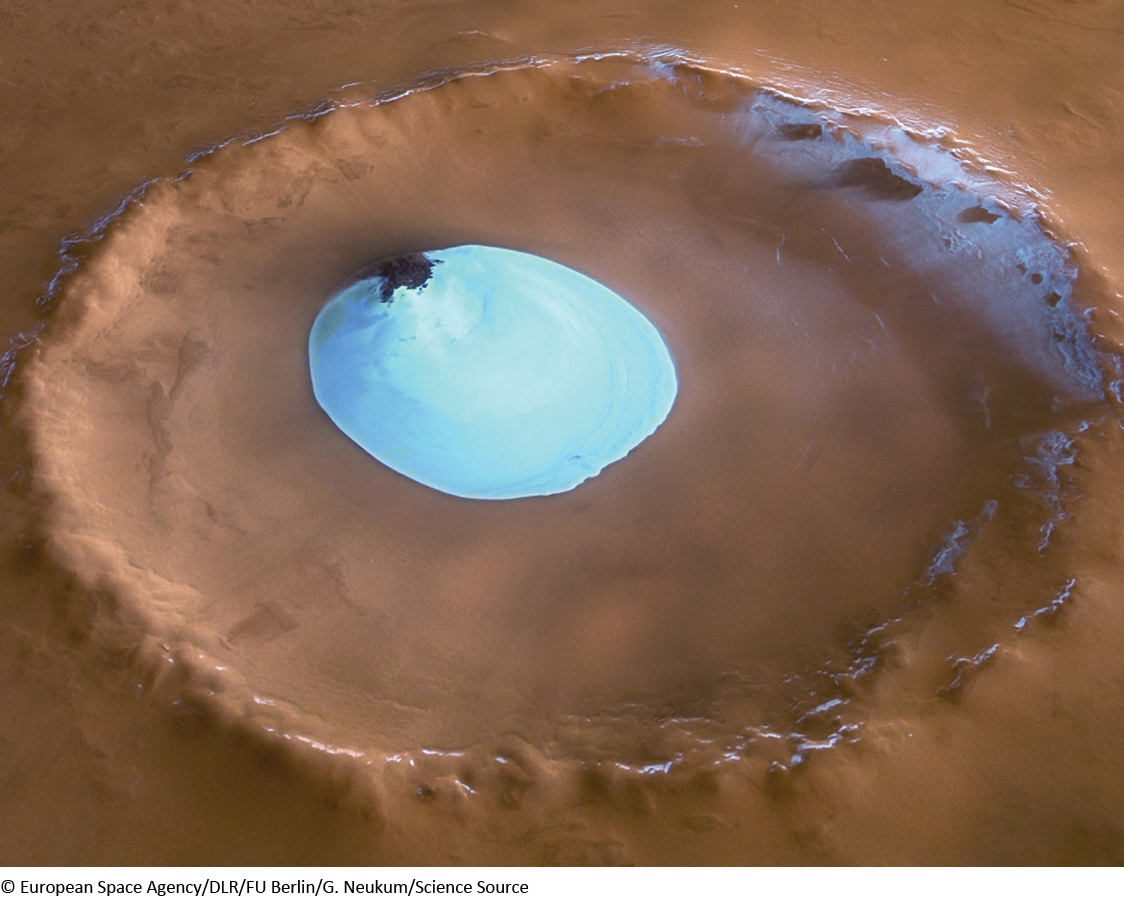8-2 Europa and Mars have the potential for life to have evolved
If life evolved on Earth from nonliving organic molecules, might the same process have taken place elsewhere in our solar system? Scientists are beginning to carefully scrutinize the planets and moons in an attempt to pursue this question. The first step is to look for places where water is abundant. As it turns out, water exists in many places besides our home planet.
Finding Liquid Water Is Essential
As far as we can tell, liquid water is essential for the survival of life as we know it. Perhaps surprisingly, the water need not be clean, cool, or pleasant by human standards. Earth’s living organisms have been found in water that is boiling hot, such as in Wyoming’s Yellowstone National Park. At the same time, life has been found to exist happily in environments that are ice cold, such as in Antarctica’s ice. Other surprising environments that were once thought to be inhospitable for life have turned out to be perfectly fine for some types of living bacteria—fiercely acidic, amazingly salty, and deep underground environments, and even on the unprotected surface of the Moon. The key is that the water must be liquid at least once in a while in order for life to use the water to survive. In order for water on a planet’s surface to remain liquid, the temperature cannot be too hot or too cold. Furthermore, there must be a relatively thick atmosphere to provide enough pressure to keep liquid water from evaporating. Of all the worlds of the present-day solar system, only Earth seems to have the right conditions for water to remain liquid on its surface. But when we expand our search for liquid water that exists within ice or beneath the surface, an entirely new realm of possibilities arises within our solar system. As it turns out, we now know that water is highly common throughout the solar system (Section 5.1), and Earth is not even the largest repository.
Our best example comes from moons orbiting Jupiter. (Chapters 5 and 6 cover evidence for water elsewhere in our solar system.) There is compelling evidence that Europa has an ocean of water beneath its icy surface. As this moon orbits Jupiter, Europa is caught in a tug-of-war between Jupiter’s gravitational influence pulling it inward and those of Jupiter’s other large moons pulling it outward. This flexes the interior of Europa, and this flexing generates enough heat to keep subsurface water from freezing. There may even be thermal vents on Europa’s ocean floor, heating the ocean from underneath, such as those on Earth shown in the chapter opening photos. Chunks of ice on Europa’s surface are able to float around on this underground ocean, rearranging themselves into patterns revealing the liquid water beneath. No one knows for sure whether life actually exists in the liquid ocean beneath Europa’s thick, icy crust. This might be true on other moons of the outer solar system as well. And, if it is true throughout our solar system, what about the nearly countless other planets orbiting other stars in the night sky?
193
Question
ConceptCheck 8-4: Why would scientists be quite surprised to find life on the Moon?
Searching for Life on Mars
Another strong possibility for finding evidence of past or present life is Mars. The present-day Martian atmosphere is so thin that water can usually exist only as ice or as a vapor. However, images made from Martian orbit show dried-up streambeds, flash flood channels, and sediment deposits. These features offer tantalizing evidence that the Martian atmosphere was once thicker and more protective, allowing water to flow freely over the planet’s surface. Could life have existed on Mars during its “wet” period? If so, could life—even in the form of hard-to-detect microorganisms—have survived just below the surface as the Martian atmosphere thinned and Mars’s surface water either froze or evaporated?
How would we know if life exists or existed on Mars? If we consider the history of Mars exploration, we can begin to see how our evolving scientific thinking impacts the way we design experiments to study Mars. One strategy is to recognize that life processes change a planet’s environment and go to Mars and look for these signs. Our first direct attempt to look for life on Mars took place in 1976, just after our manned exploration of the Moon was abandoned. Two unmanned spacecraft landed on different parts of Mars in search of answers to these questions. Viking Lander 1 and Viking Lander 2 each carried a robotic scoop at the end of a mechanical arm to retrieve surface samples to look for biological activity. These samples were deposited into a compact on-board biological laboratory that carried out three different tests looking not simply for chemical evidence of water but for evidence of Martian microorganisms.
- The gas-exchange experiment was designed to detect any processes that might be broadly considered as respiration. A surface sample was placed in a sealed container along with a controlled amount of gas and nutrients. The gases in the container were then monitored to see if their chemical composition changed.
- The labeled-release experiment was designed to detect metabolic processes. A sample was moistened with nutrients containing radioactive carbon atoms. If any organisms in the sample consumed the nutrients, their waste products would include gases containing the telltale radioactive carbon.
- The pyrolytic-release experiment was designed to detect photosynthesis, the biological process by which terrestrial plants use solar energy to help synthesize organic compounds from carbon dioxide. In the Viking experiments, a surface sample was placed in a container along with radioactive carbon dioxide and exposed to artificial sunlight. If plantlike photosynthesis occurred, microorganisms in the sample would take in some of the radioactive carbon from the gas.
The first data returned from these experiments caused great excitement, for in almost every case, rapid and extensive changes were detected inside the sealed containers, suggesting that microbial life had been found on Mars. More in-depth analysis of the data, however, led to the conclusion that these changes were due entirely to nonbiological chemical processes. It appears that the Martian surface is rich in unstable chemicals that react with water to release oxygen gas, a process that is easily mistaken for biological activity. Because the present-day surface of Mars is bone dry, these chemicals had nothing to react with until they were placed inside the moist interior of the Viking Lander laboratory.
At best, the results from the Viking Lander biological experiments were inconclusive. Perhaps life never existed on Mars at all. Or perhaps it did originate there but failed to survive the thinning of the Martian atmosphere, the unstable chemistry of the planet’s surface, and exposure to ultraviolet radiation from the Sun. (Unlike Earth, Mars has no ozone layer to block ultraviolet rays.) Another possibility is that Martian microorganisms have survived only in certain locations that the Viking Landers did not sample, such as isolated spots on the surface or deep beneath the ground. And yet another option is that there is life on Mars, but the experimental apparatus on board the Viking Lander spacecraft was not sophisticated enough to detect it.
Mars seems to be the best candidate for finding where life exists beyond Earth because it once had significantly more water on its surface.
As our scientific thinking changed, so did our approaches to searching for life on Mars. What we did not fully understand is the much wider diversity of hospitable living environments that is possible. As we look around own planet, we find life-forms not only just barely surviving, but flourishing and reproducing in environments once considered too extreme to be hospitable for life. As shown in Figure 8-5, we have found life-forms living in the superheated water above boiling temperatures in Yellowstone National Park and around geothermal vents near the bottom of the ocean. They can exist deep under the ice of Antarctica and in both acidic and salty lakes. Perhaps most surprising, scientists have also found extremophiles living as slime inside a nuclear reactor and even some that can survive in the harsh environment of outer space. These discoveries dramatically change how we think about life and help us focus on looking for the only thing common in all these environments—the existence of liquid water, even if for only the briefest amounts of time in the tiniest quantities.

194
Question
ConceptCheck 8-5: What observations were scientists using the Viking Landers hoping to make that would allow them to infer that microbes were living in the Martian soil?
New Evidence for Martian Water
 Go to Video 8-1
Go to Video 8-1
Scientists searching for evidence of Martian life have been encouraged by other spacecraft that have provided new evidence of water on Mars. The Mars Reconnaissance Orbiter began orbiting Mars in 2006 and has been using a host of modern scientific instruments to systematically analyze the landforms, surface composition, weather systems, and ice on Mars. Figure 8-6 is an image captured by this spacecraft’s high-resolution camera and showing channels cut into the walls of a crater, apparently by water. Since that time, we have discovered even more direct evidence for water on Mars. Just a few years later, the Mars Phoenix Lander was outfitted to dig for evidence of water near the Martian south pole. Images of a small trench dug by the spacecraft that were taken over several days show that water ice, seen as white in Figure 8-7, quickly disappears when hit by warming sunlight.

Scientific discoveries, such as finding evidence for water on Mars, are not conclusive with just a single observation. Instead, scientific discoveries are only taken seriously by the scientific community when there are multiple lines of evidence that all focus on the same idea. As another line of evidence about Martian water, consider that the Mars Express spacecraft, which went into orbit around Mars in December 2003, used its infrared cameras to examine the ice caps at the Martian north and south poles (Figure 8-8). These cameras allowed scientists to see through the Martian ice cap’s surface layer of frozen carbon dioxide and revealed underlying layers that appear to be water ice.
195
In January 2004, NASA successfully landed two robotic rovers named Spirit and Opportunity at two very different sites on opposite sides of Mars. While the terrain around the Spirit landing site appears to have been dry for billions of years, Opportunity landed in an area that appears to have been under water for extended periods (Figure 8-9a). Measurements made by Opportunity confirm that some of the very dark surface material at its landing site contains an iron-rich mineral called gray hematite (Figure 8-9b). On Earth, deposits of gray hematite are commonly found at the bottoms of lakes or mineral hot springs. The presence of gray hematite at the Opportunity site reinforces the argument that Mars once had liquid water on its surface and helps hold open the possibility that living organisms could have evolved on Mars.


More recently, the Curiosity rover has made significant new observations about the chemical nature of rocks on the surface of Mars. Curiosity’s recent discoveries are described in Chapter 6 and most certainly newer ones exist since the time of this writing.
196

Question
ConceptCheck 8-6: Why are astrobiologists excited about finding gray hematite rocks on Mars’s surface?